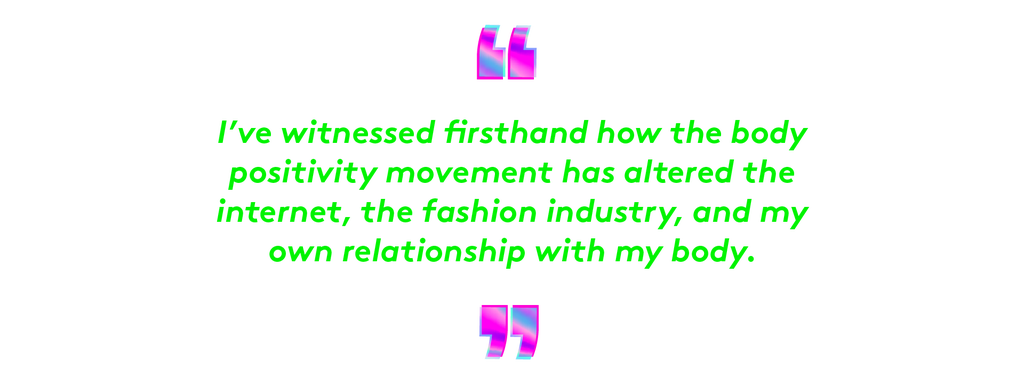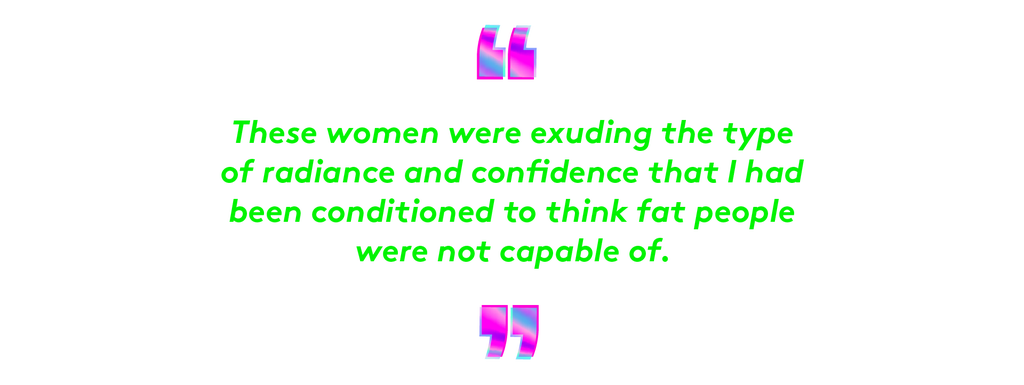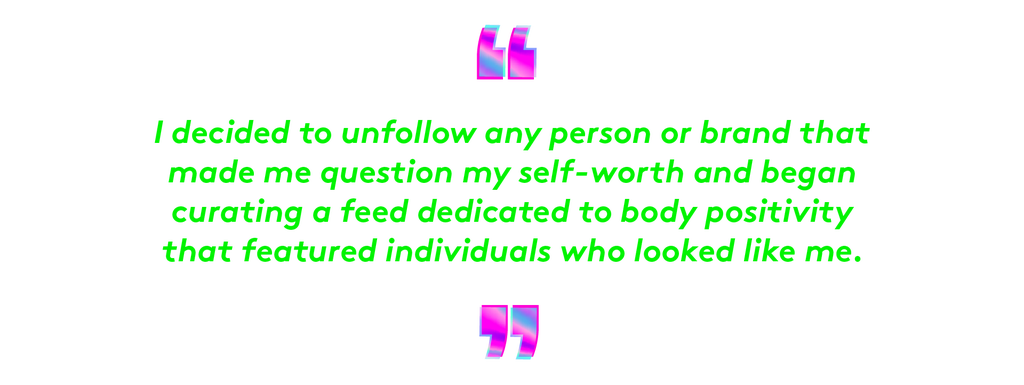The first time I realized that I was supposed to be ashamed of my body I was in my school cafeteria eating lunch. I was 10. Another student began explaining to everyone how she “never wanted to be fat like her mom.” I looked down at my own body, and I felt ashamed. I was already fat, and therefore couldn’t say that I never wanted that for myself. I realized how concerned my peers were with their weight and appearance, and I slowly began to obsess over mine. I had never given a lot of thought to my size, but now all I noticed was how I was just a little too big for my favorite dress from Limited Too. These insecurities started to grow and took vicious hold over my self-confidence for the majority of my adolescence.
Throughout my early teen years, I did everything in my power to create the illusion that I was smaller than I actually was. This took the form of wearing Spanx to the school dance, lying about my weight on my learner’s permit, or choosing to be quiet and timid so that I could take up the least amount of space possible with not just my body, but my personality as well. The internet continued to fuel my disdain for my own body. On Tumblr, my feed was filled with thin bodies and thigh gaps. On Twitter I witnessed Miley Cyrus complain about how when she jiggled her thighs, they “shook on their own for 3 Mississipis.” With my eyes fixed on each feed, I was constantly reminded that nobody wanted to have a body like mine.

For years, magazines had only shown me thin women, articles and ads told me how to lose impossible amounts of weight in short periods of time, and the only time I had seen a fat woman on the TV was so she could be the butt of a joke, or have a dramatic transformation and finally find love. At the time, I didn’t realize how these things affected me; it never crossed my mind that the disgust I had for my body — and fat bodies, in general — was an issue; it was just a fact of life. But then the body positive movement shook the very foundation that my insecurities and self-hatred stood on.
The concept of “body positivity” became popular on social media less than a decade ago; terms like “body inclusivity” and “body neutrality” are even more recent additions to our online vocabulary. Today, we’re inundated with imagery that is synonymous with body positivity, even in places where extreme thinness once ruled. In late September, Versace sent three plus-size models down the runway. That same month, boho-chic wedding brand BHLDN, pricey athleisure favorite Lululemon, and sustainable dressmaker Christy Dawn all launched inclusive sizing. Much of this changing fashion landscape can be attributed to the rise of the body-positive movement in social media. This change came at a crucial time in my life. I’ve witnessed firsthand how it has altered the internet, the fashion industry, and my own relationship with my body.

When I joined Instagram in 2011, my feed was filled with low-quality photos posted by my friends. The main focus was dogs, food, and social events. The platform was soon infiltrated by bloggers, brands, and celebrities — a process hastened by how easy it was to monetize content. Once again I was surrounded by images that set high and unattainable expectations for my body. Then I came across Gabi Gregg’s profile, and everything changed. In her bio, Gregg describes herself as the “OG Fat Girl,” and to me these words could not be more resonant. She was the first person I found on Instagram who was unapologetically herself, despite the way the world talked about plus-size bodies. I was in awe of her and wanted to know more about the body positivity movement and community.
After following Gabbi, more and more plus-size bloggers began to show up on my explore page. The number of similar accounts I followed steadily grew, and my feed became more inclusive. I finally saw women who looked like me. These women were exuding the type of radiance and confidence that I had been conditioned to think fat people were not capable of.
I found myself being kinder to myself and more loving towards my own body. The constant pressure and need to lose weight stopped clouding my mind. I started to see diet culture for the harmful system that it is and realized how much the media I consumed controlled my insecurities. I decided to unfollow any person or brand that made me question my self-worth and began curating a feed dedicated to body positivity that featured individuals who looked like me. By taking control, I was able to create a community that challenged me to question my own feelings of insecurity and replace them with ones of confidence.

This type of power is relatively new. Prior generations of teens couldn’t personalize magazine covers or commercials. This ability to pick and choose what your feed looks like can be both a blessing and a burden. It shouldn’t be only the responsibility of individuals to create their own communities in order to see people who look like them. And there is still plenty of messaging and social media out there that promotes fatphobia and diet culture. If I had never come across the plus-size community online, there is a chance that I would still be scrolling through a feed that made me feel disdain for myself. Even though I can’t tell my 10-year-old self this, I’m glad that other 10-year-olds will come to know that they don’t need to feel shame surrounding their bodies. They can create communities that will bring them joy and empowerment. When they find that for themselves they will know they are finally in the right place.
Ansley Morgan is a New York-based writer and stylist who focuses on body positivity and what that looks like within the fashion industry. Follow her on Instagram @ansleymorgan.
It’s a cliche, but this year was supposed to be our year — full of independence, opportunity, or at least a few weekend afternoons spent with more than 10 friends with fewer than six feet between us. But with COVID-necessary social distancing, a shitty job market, closed campuses, 2020 hasn’t given us much to work with. Past generations have had to deal with a recession, social upheaval, and changing norms: We’ve had to deal with all of it at once.
So, what now? What do we do with our careers, our relationships, and our lives? How do we move forward when we’re still stuck in our high school bedrooms? These stories are for us — filled with the resources, blueprints, and people who are finding ways to turn all this garbage into something like lemonade.
Like what you see? How about some more R29 goodness, right here?
from Refinery29 https://ift.tt/3kFn4lS
via IFTTT

